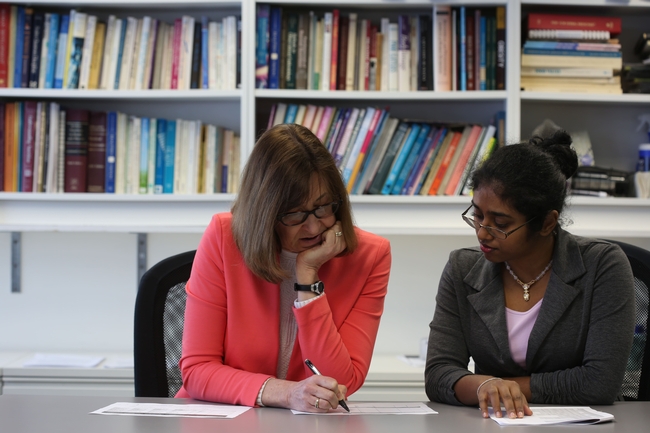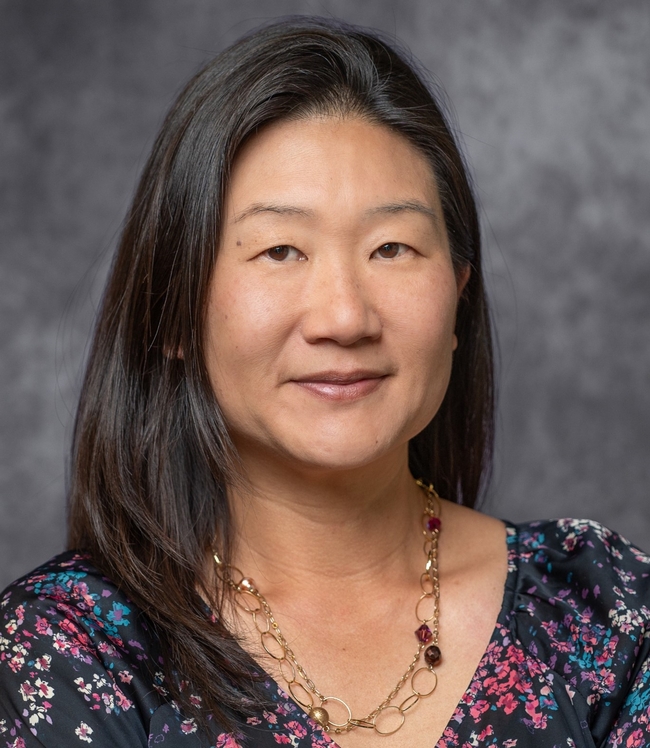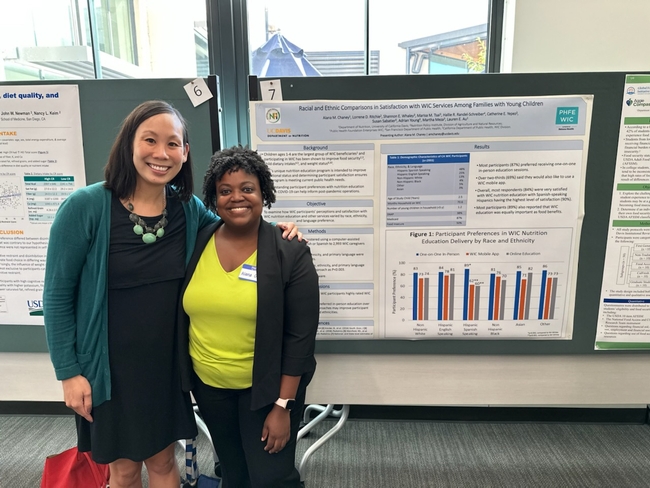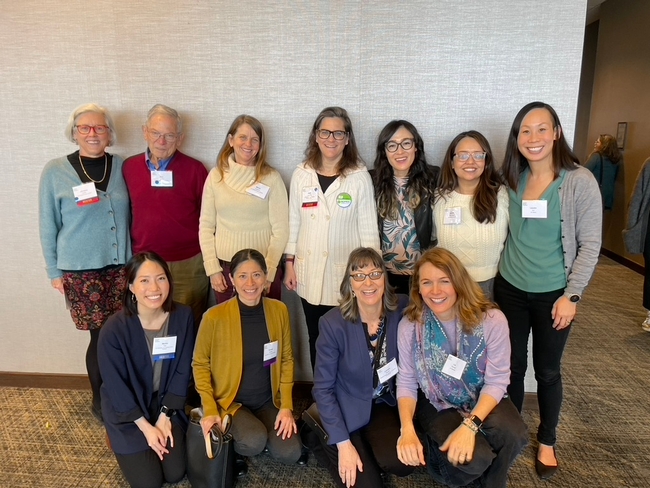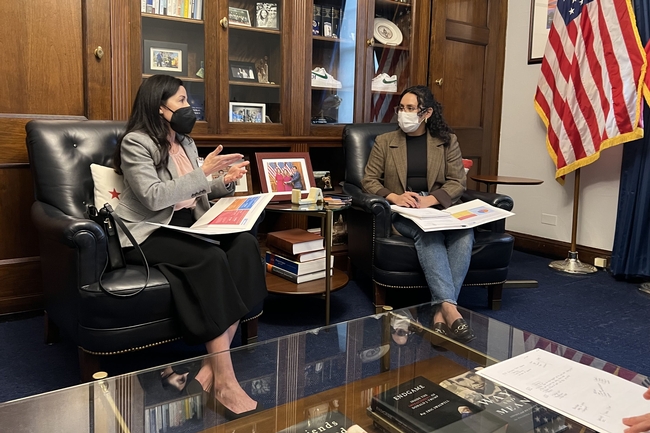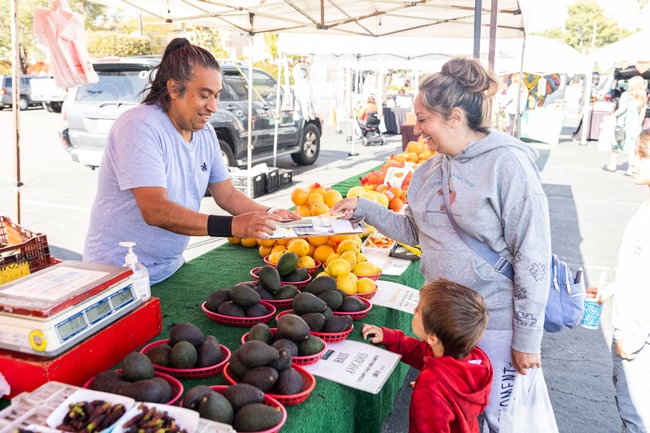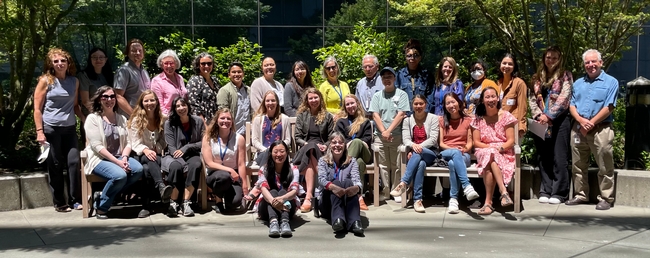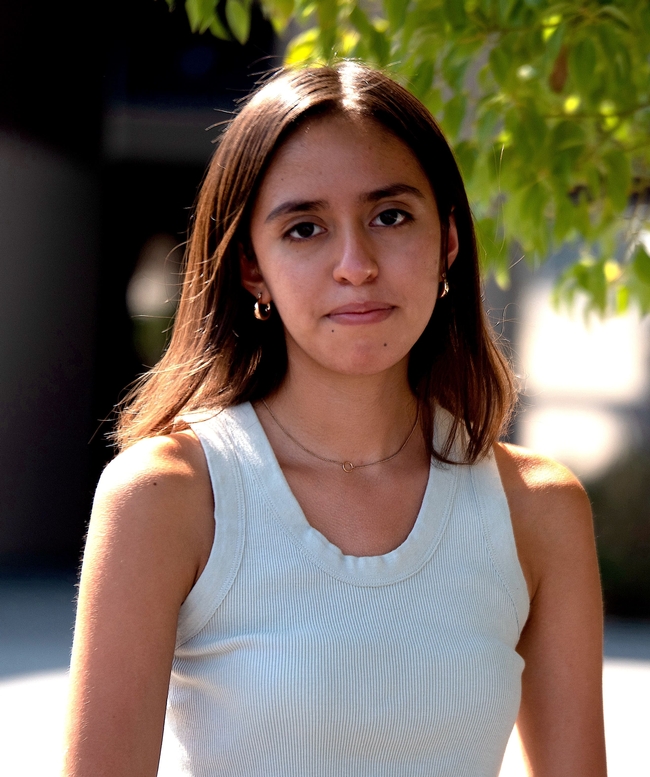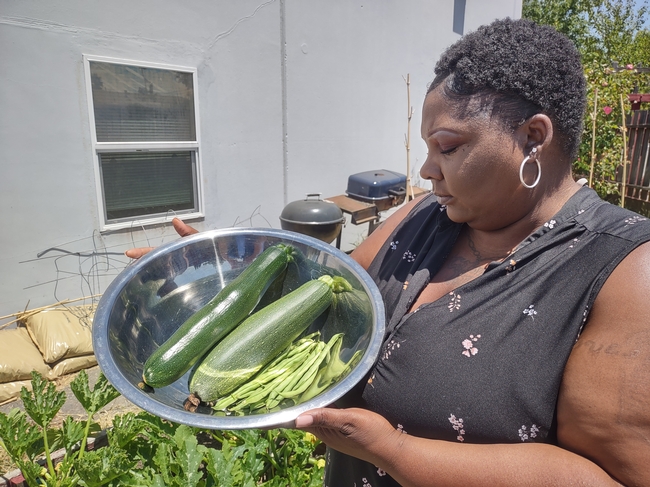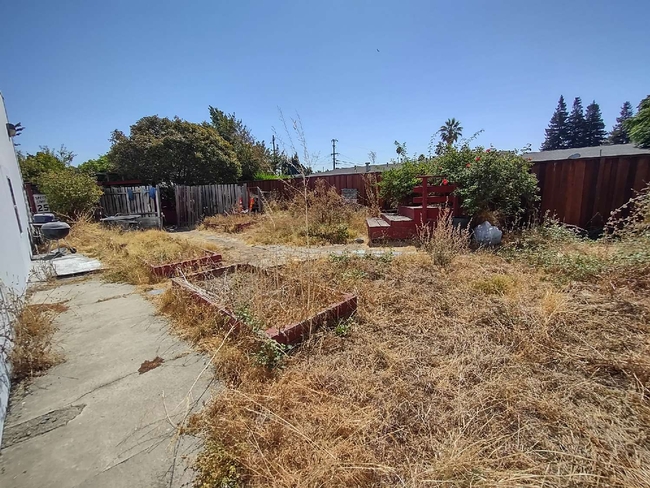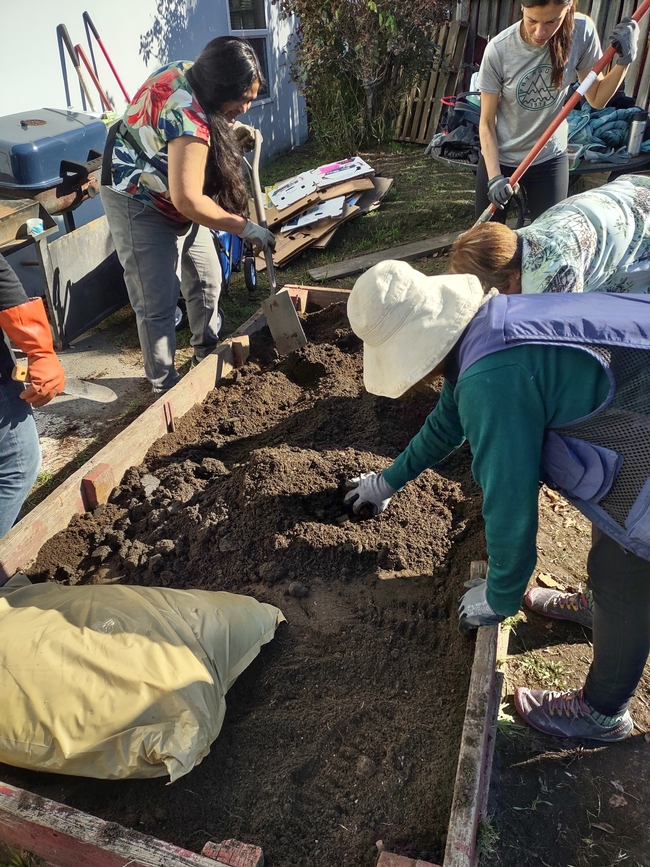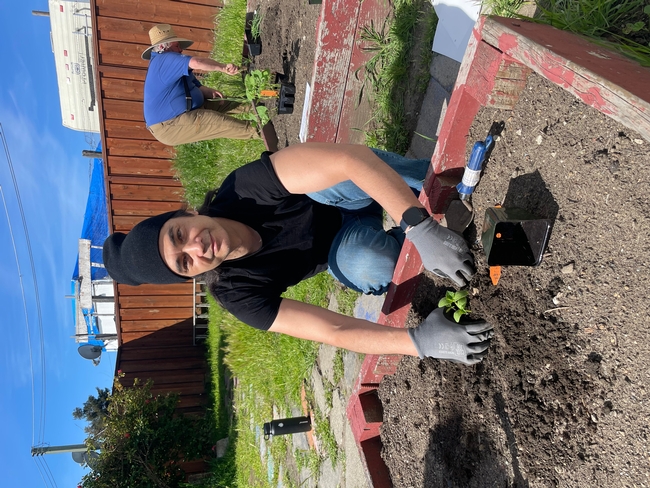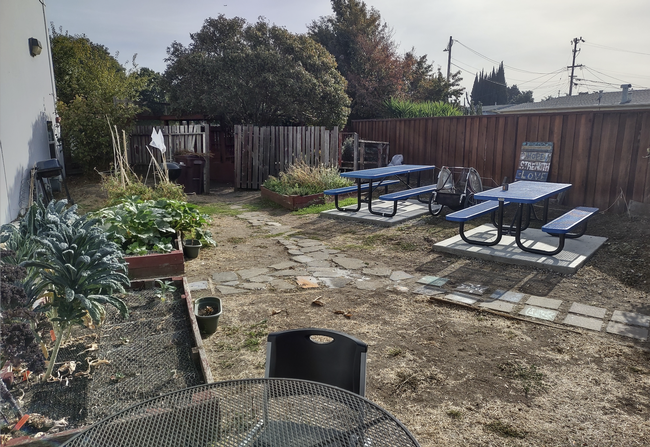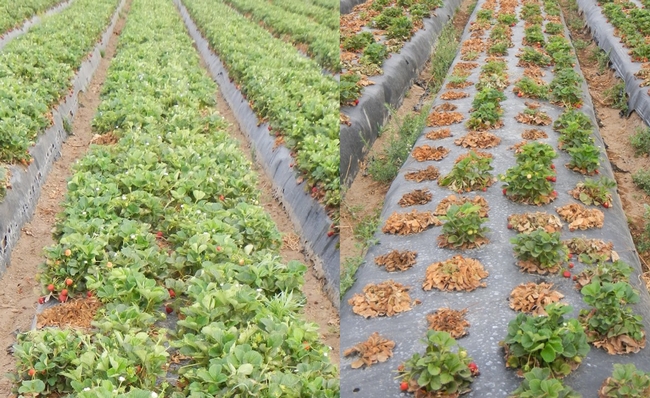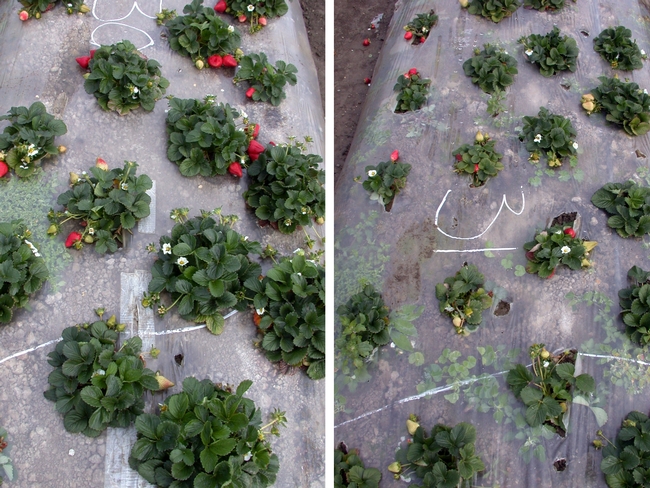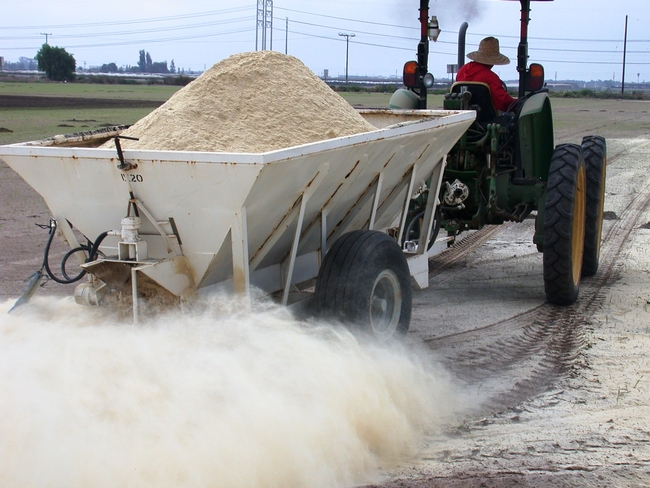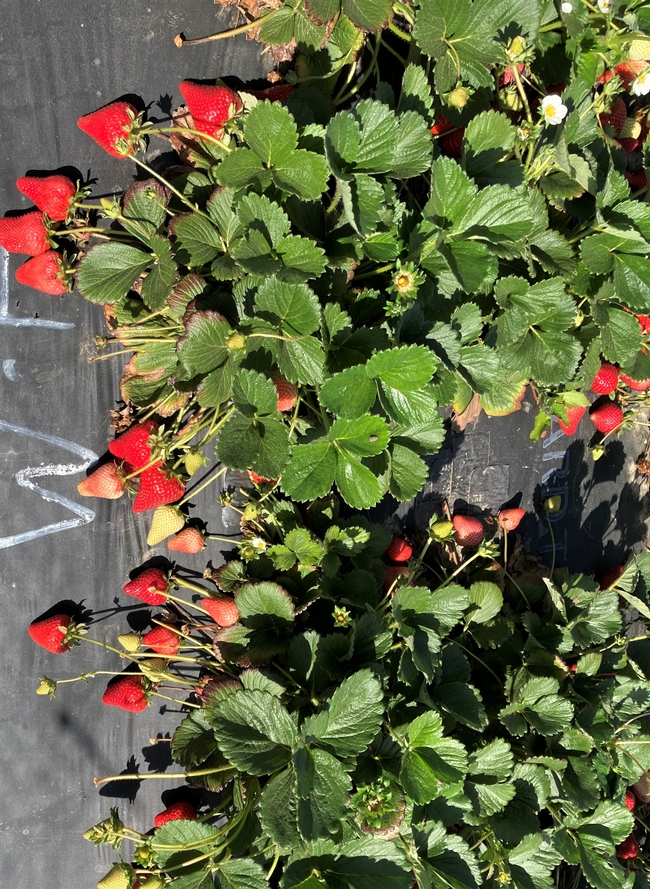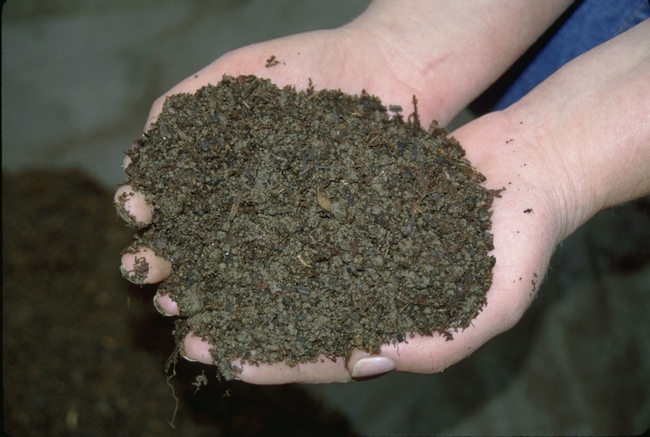
Posts Tagged: healthy
Nutrition Policy Institute: 10 years of making healthy choices more accessible for all
NPI researchers provide influential evidence that shapes federal, state nutrition programs
Of the many challenges facing humanity, nothing is more fundamental than securing healthy food and water for all. Life itself would not be possible without nutrients, energy and water – but for many people across the United States, that essential fuel is compromised.
“Right now, the average American diet quality has a failing grade,” said Lorrene Ritchie, University of California Cooperative Extension nutrition specialist. “If you scored it from 0 to 100, it would be about 55 to 60. And we're trying to move that number closer to 80.”
To help society reach that goal, the Nutrition Policy Institute was established 10 years ago, under the UC Agriculture and Natural Resources umbrella.
“NPI was created in recognition of the fact that more people in the United States are now ill with a nutrition-related chronic disease than are well,” said Ritchie, who has been director of the institute since its founding. “Six in 10 adults in the U.S. have one or more chronic diseases – 4 in 10 have two chronic diseases – that are preventable. When you have that big of a public health nutrition problem, the scope requires big policies, big program changes and big environmental changes.”
Since 2014, NPI – building upon the work of the Center for Weight and Health at UC Berkeley – provides scientific data to inform and guide a host of nutrition improvements across wide swaths of the population, with a focus on low-income and racially and ethnically diverse communities.
The work of NPI's 40 academics, staff and students have furnished policymakers, program managers and school administrators with the pivotal research that, among other things, has enhanced access to federal nutrition programs, reduced food insecurity for children of all ages, and removed unhealthy snack foods and beverages from schools while boosting access to drinking water.
And with about 1 in 3 people in the U.S. touched by federal nutrition programs, NPI experts have become instrumental in evaluating programs such as SNAP (Supplemental Nutrition Assistance Program, popularly known as food stamps or CalFresh in California) and SNAP-Education, WIC (Special Supplemental Nutrition Program for Women, Infants and Children), school meal programs, and the Child and Adult Care Food Program.
“This institute is the only one of its kind on the West Coast, with a very substantial number of graduate-level nutritionists and policy experts who are ready and able to take on policy questions that are being considered at the federal, state and local levels,” said Pat Crawford, a pioneer in the field of nutrition policy and the founding director of the UC Berkeley Center for Weight and Health, which merged with NPI in 2015.
In assessing NPI's overall contributions to the nutrition and public health space, Ritchie is astonished by the work of its academics and staff.
“Our findings have really informed policy and moved the field in a way that I could have hardly conceived of 20 or 30 years ago, when I first started working in this area,” she said. “I could not imagine that we would have achieved all the policy impacts that we have.”
Trusted partners in researching school meal programs
An illustrative example of NPI's prominence in nutrition policy research is its leading role in studying California's effort to provide school meals for all students.
The Nutrition Services Division of California's Department of Education oversees virtually all meal programs in public schools across the state, serving 870 million meals and snacks each year to about 5.8 million students.
According to its director, Kim Frinzell, the division relies on NPI to help evaluate and understand the emerging trends at schools by gathering and analyzing feedback from students, teachers, food service directors, parents, community organizations and other partners. With a better pulse on these trends, Frinzell's team uses the data to inform its policies, practices, training and overall strategy.
“NPI brings the expertise of knowing what kind of research questions to ask; as a state agency, we don't have research resources, nor the specific expertise,” Frinzell said. “So being able to partner with NPI is an incredibly valuable service.”
In addition to working with Christina Hecht on drinking water access and Wendi Gosliner on food waste issues, the California Department of Education has partnered with NPI researchers in recent months to conduct surveys and organize focus groups on California's universal school meals program, School Meals for All.
Coming out of the COVID-19 pandemic, California was one of the first states in the U.S. to adopt a universal school meals program, offering breakfast and lunch at no cost to all K-12 students, regardless of household income. NPI was funded to evaluate the implementation and impact of the program.
“The great value of what NPI brings to School Meals for All is that their work is not just quantitative but qualitative, value-added information that tells a story about real individuals and real situations that is backed by the data about a particular program, and you're able to anchor back to a very well-respected institute and the research they've done and say: ‘This is what the survey says, this is what the evaluations and the data provide,'” Frinzell explained.
“What's been really wonderful about NPI over the past 10 years is they're such leaders in studying and helping to create strategies for greater access to healthy meals for all – while also promoting healthy habits for all – across the entire child-nutrition spectrum,” Frinzell added.
Pioneers in researching universal school meals
May Lynn Tan was one of the first students working at NPI. She was interested in learning about universal school meals and accessed data on meal programs from across the U.S. using Lorrene Ritchie's work on a nationwide collaborative school nutrition project.
“At the time, there was not a lot of evidence on the impact of universal meals on participation, because there just weren't that many places where that was happening,” Tan said. “So that data set really helped illustrate some of these patterns that I wouldn't have been able to get at, otherwise.”
Tan chose this topic for her doctoral dissertation. She concluded that students who previously had been ineligible for free or reduced-price meals experienced the greatest impact through universal school meal programs. “It really just went to show that when you offered universal meals in schools, the kids who weren't qualified to get them for free before, but who still needed them, could start participating at a higher rate,” said Tan, noting that her research continues to be used in modeling to predict the effects of such programs in other states.
Presently, as director of research and strategic initiatives for California Association of Food Banks, Tan is thankful for her relationships with NPI team members – and regularly accesses NPI resources and briefs (compiled by NPI communications director Danielle Lee, in collaboration with other NPI researchers) to stay abreast of the latest research.
“NPI does a really good job packaging their findings for practitioners who are managing and providing services for communities,” Tan said. “That's really important in this field, because policymakers and program staff don't necessarily want to wade through a giant study. NPI often puts out one-pagers and things that are more graphically designed that make it easy to understand the findings – and what they mean for the real world.”
Experts in examining WIC program policies, impact
In the early 2010s, Lauren Au was working in Washington, D.C. as a U.S. Senate nutrition advisor, providing lawmakers with the latest research on nutrition programs. But she sought a more active role in the field.
“Instead of being the legislative assistant who's meeting with constituent groups that are giving me their one-pagers about why their legislation should be supported, I wanted to be driving the research that's behind that one-pager,” Au explained.
Having studied with Pat Crawford as an undergraduate student at UC Berkeley, Au returned to the West Coast in 2014 as a postdoctoral researcher with NPI. One of her projects was a long-term study of children, from birth to age 9, participating in the WIC program.
Au's experience in studying WIC – including its pandemic-era changes that increased fruits and vegetables and offered online options for participant enrollment, recertification and education – allowed her to carve out her own niche in the academic space. She cited that research focus, along with the collaborative relationships she cultivated at NPI, as major reasons for her success as a recently tenured professor in the Department of Nutrition at UC Davis.
“I love this work because you're constantly learning and keeping up with where the field is going,” Au said. “I've seen, over time, how it's changed from focusing on obesity to now focusing more on the social determinants of health. And that's where my research has shifted as well, becoming broader and seeing how all these environmental influences play a role in impacting nutrition and public health.”
Trailblazers in studying policy, systems and environmental approaches
NPI's work has been a driver of the field expanding its focus to research and interventions beyond the individual (such as direct education efforts) to the social, cultural and environmental context.
“We know now that nutrition is absolutely one of the determinants of all of the chronic diseases that we're suffering from in this country, whether it be cancer, heart disease, stroke, diabetes or obesity,” said Crawford, emeritus CE nutrition specialist and adjunct professor of public health. “And we've learned that it takes more than just educating people – it really takes policymakers to help make those good, nutritious choices easier for the public.”
Sugar-sweetened beverages, for example, have a significant negative impact on children's diet quality and health, according to Ritchie. And because such beverages are heavily marketed and ubiquitous, parents and caregivers are challenged to make the right choice – even if they know about their harms.
“Regardless of the quality of the education, the onus is on the parents to remember to make the healthy choices, which can be hard when kids naturally love sweets, and given the influence of kids' ‘pester power,'” Ritchie explained.
To help those dietary decision-makers, a bill was passed in California to make the healthy choice (i.e., milk or water) the “default” beverage offered with kids' meals served in restaurants. Since that law went into effect in 2019, its efficacy – and shortcomings in practice – and have been extensively studied by NPI's CalFresh evaluation team.
Innovators in SNAP, SNAP-Ed evaluation
Federally funded by the United States Department of Agriculture, the California Department of Public Health oversees SNAP-Ed (known as CalFresh Healthy Living at the state level) as the largest of four CFHL state implementing agencies to fund work in California's 61 local health departments. CDPH contracted with NPI (and before that the Center for Weight and Health) to conduct ongoing comprehensive evaluation of CalFresh Healthy Living interventions, including individual education and behavior change as well as broader systems approaches.
“NPI has been a wonderful partner and contributed a tremendous amount in how CalFresh Healthy Living evaluates its work, especially as policy, systems and environmental change approaches have evolved and been encouraged over the years,” said Erica Eilenberg, chief of CDPH's Nutrition and Physical Activity Branch.
While developing more efficient systems and processes for tracking, evaluating and reporting results of CalFresh Healthy Living initiatives across California, NPI also provides technical assistance to local health departments in collecting crucial data and measuring outcomes. In particular, NPI researchers helped develop an innovative “dose score” method to quantify the cumulative and combined impact of multiple interventions at school sites – as opposed to measuring each type of intervention independently.
As a result, more robust evaluation data and reporting have provided local health departments with key information to improve their program planning and delivery.
“NPI's evaluation work has resulted in more effective initiatives that have contributed to improving food and nutrition access for many CalFresh Healthy Living-eligible participants across California,” said Eilenberg, who added that NPI academics are valued contributors to state-level workgroups and national committees advising SNAP-Ed.
Respected voices on food insecurity, nutrition in higher education
One of the many NPI-affiliated researchers who have become prominent voices at the national level, Suzanna Martinez was among the 500 invited attendees at the 2022 White House Conference on Hunger, Nutrition and Health – the first convening of its kind since 1969. Many of the conference's recommendations, outlined in the Biden-Harris administration's national strategy, are supported by research underpinnings from NPI and its partners.
Martinez was invited to the conference because she's part of a UC effort to halve, by 2030, the number of students in the UC system who are facing food insecurity – meaning they are regularly unable to access enough food for a healthy lifestyle.
Now an associate professor in the Department of Epidemiology and Biostatistics at University of California San Francisco, Martinez said her research on student food security in higher education was a direct result of her time at NPI. One of the first researchers to join NPI in 2014, she began working with Ritchie on a groundbreaking, systemwide survey about food security across the UC system.
“Up until that point, there had only been some smaller studies, convenience sample surveys of community college students, and so this was one of the bigger studies to look at this issue in a large public university system,” said Martinez, who noted that she had to be resourceful to avoid being food insecure as a graduate student.
Their initial study found that 4 in 10 UC students were facing food insecurity – a startling statistic that provided hard evidence to policymakers on the need for additional funding and resources, such as campus food pantries. In subsequent years, Martinez and NPI colleagues partnered with staff at UC campus basic-needs centers to pinpoint the barriers preventing greater student access to food assistance – and offered potential ways to streamline processes.
Follow-up surveys indicated improvement in food security at UC locations, until the pandemic halted that progress. Nonetheless, Martinez – who continues to intensively study the subject – said that NPI's broad platform was crucial in spotlighting food needs at colleges and universities.
“It was important, at that time, that this work came out of NPI,” she said. “I don't think it would have had as much impact as it has had because of where the work was coming from.”
Growing as a key source of research in food systems
The depth and breadth of NPI's influence is even more striking given the “youth” of nutrition policy as a field in public health nutrition, which dates back only about 50 years.
“For the applied nutrition policy research that we do at Nutrition Policy Institute, it's only in the last couple of decades that we've really been doing research to see how policy, systems and environmental change can support behavior changes of everyday people like you and me,” Ritchie said.
She pointed out that NPI's partnerships are key to expanding its reach. Partners assist in bringing NPI's rigorous research to legislators, policy staff and the people who manage and deliver nutrition programs. By working with state entities like the Departments of Education, Public Health, Social Services, and Food and Agriculture – as well as organizations such as the California and National WIC Associations, CACFP (Child and Adult Care Food Program) Roundtable and the Center for Science in the Public Interest – NPI researchers provide key data to decision makers and advocates, and receive critical guidance on their research projects in return.
“We are researchers, but we are not on the ground implementing these programs and policies and we absolutely cannot do the work that we do without our partners,” Ritchie explained. “Asking the right questions of the right people is really hard to figure out if we don't have the community partners at the table.”
By virtue of its place alongside UC ANR experts on agriculture, natural resources and the environment, the NPI team is also connected to an even larger community of farmers, producers and other people along the food supply chain. Ritchie envisions, in the next decade, NPI taking a larger role in examining and improving the greater food system. As Wendi Gosliner and Ron Strochlic did through NPI's involvement in a recent project linking local growers with state correctional facilities, UC ANR can help connect the many scattered dots from farm to fork – from the food production side to the consumer nutrition side.
“Looking toward the future, that's the kind of thing I'm most excited about – helping those two arms, and everybody in between, talk to each other so that agricultural decisions are made thinking about human and planetary health, and nutrition decisions by consumers are made thinking about both planetary and human health,” Ritchie said. “We're going to need to do that to address climate change.”
‘We can see where the future is headed'
Meeting the challenges of the climate crisis – as well as incipient global health crises – will require a continued influx of talent, innovation and new ideas.
“The U.S. is now leading all nations in the prevalence of chronic disease, and what happens here, in terms of our food system, often gets exported all around the world,” Ritchie said. “We can see where the future is headed, and what we need to do is to figure out how to go back to a healthier lifestyle and a healthier diet. So the field of nutrition policy research, though there aren't that many of us, needs the brightest and best minds, the most enthusiastic and passionate people.”
The NPI Student Fellowship, established in 2019 in honor of Pat Crawford, has funded about a dozen students to work with NPI researchers on a variety of projects. While they gain hands-on research skills, glimpses of potential career paths, and access to nutrition professionals and resources, they also contribute their own diverse perspectives.
“We intentionally recruit students with this fellowship funding who bring a diversity of lived experiences.” Ritchie said.
“Students participate in interdisciplinary and cross-cultural discussions on research design and data interpretation,” Crawford added.
Brianna Aguayo, a second-year undergraduate studying nutritional sciences at UC Berkeley, is a first-generation Latina college student currently working at NPI through the fellowship program. Growing up in East Palo Alto, Aguayo saw how systemic barriers prevented community members from accessing vital nutrition assistance and resources.
Through her time at NPI, Aguayo has gained new insights on how researchers, policy analysts and communication specialists work together to generate the scientific evidence that can improve federal, state and local policies so they can potentially benefit more people. That knowledge will only enhance her ability to create positive change in her community, as she plans to incorporate that public health policy perspective along her journey to becoming a pediatrician.
“It's not just one sole person making this change,” Aguayo said. “But it really takes a group effort to help initiate change, and then make sure that that change is constantly being implemented.”
People interested in supporting and celebrating NPI's first decade of research, which has led to more healthful food offerings to vulnerable children and their families, can donate to NPI's Student Fellowship. It provides students from underrepresented groups the opportunity to work with NPI, learn from NPI and continue after graduation to improve nutrition for all. An anonymous matching gift of up to $10,000 will double every donation made through June 30, 2024.
Homeless people cultivate food, better health while gardening in Alameda County
Fresh fruits and vegetables are essential to a healthful diet, but it's hard to keep perishable foods on hand if one doesn't have a refrigerator or a home. To enhance the health of homeless people, the CalFresh Healthy Living, UC Cooperative Extension team in Alameda County has partnered with the South County Homeless Project to grow fresh produce for people staying at the emergency housing in Hayward.
For the past seven years, CalFresh Healthy Living, UCCE Alameda has been delivering nutrition lessons to residents of the South County Homeless Project, part of Building Opportunities for Self Sufficiency. The classes include Rethink Your Drink, Food Safety, Making Every Dollar Count, Eat Healthy Be Active Community Workshops, and Fresh from the Garden.
The South County Homeless Project facility houses 24 people for up to a year. With the help of the CalFresh Healthy Living, UC Cooperative Extension team, its existing garden was refurbished and redesigned. The large outdoor garden behind the facility offers therapeutic gardening opportunities to residents and provides food for their meals.
"I love the garden and when the cook cooks the vegetables, they taste amazing,” said one resident. “I am thankful for this garden and for having the CalFresh Healthy Living team.”
At one time, South County Homeless Project's backyard featured a flower garden. After years of neglect, weeds overtook the garden.
In 2022, CalFresh Healthy Living, UCCE Alameda proposed getting residents involved in growing food by resurrecting the garden with edible plants.
“Not only could we continue to engage residents in nutrition education classes, but we could also work together to reinvigorate their neglected garden,” said MaxFairbee, nutrition educator withCalFresh Healthy Living team,UCCE Alameda.
More than 15 varieties of herbs and vegetables planted
Residents and staff set out to replace the weedy beds with a vegetable and herb garden.
“We worked with South County staff and residents on the design, clean up, planting, harvesting and ultimately incorporating food from the garden into the kitchen for residents to enjoy the fruits of their labor,” Fairbee said.
For gardening expertise and support, Fairbee enlisted the UC Master Gardeners of Alameda County's Community Garden Team to help. While the CalFresh Healthy Living, UCCE staff continued providing nutrition classes, the UC Master Gardener volunteers trained the residents on the basics of gardening.
In April, after heavy rains, the group planted 50 seedlings, half donated by the UC Master Gardeners. They planted two varieties of lettuce,arugula, four varieties of tomatoes, zucchini, kale, onions, cucumbers, green beans, Swiss chard, kale, basil, cilantro, tarragon, thyme, parsley, rosemary, oregano and mint.
From garden to table
“In May, we harvested lettuce and in June, we harvested green beans, cucumbers, kale and onions,” Fairbee said.
The fresh vegetables and herbs were used to prepare salads, sandwiches and pasta dishes for the residents. Fairbee and the other educators have also used the fresh produce for cooking demonstrations and tastings as part of their Fresh from the Garden class.
"We have been able to use many of the veggies as sides or to go in the salad," said one of the South County Homeless Project cooks.
"One of the chefs used the zucchini in the pasta sauce, it was so good! I didn't really know you could use it that way!" said a resident.
After tasting summer squash andgazpacho made with tomatoes from the garden, a South County resident namedSelina said, "I was surprised how good the raw summer squash tasted and how the flavor was different after it was cooked. I'll definitely be adding more zucchini to my plate."
Challenges to keeping the garden going
To keep the garden healthy, they faced competition with plant-chewing snails, slugs and aphids and cats digging in the soil. Because the water source is over 200 feet from the garden, they run a long hose across the main path, along the parking lot to water the plants, then unhook the hose and stash it indoors after each use so that it won't get stolen.
Another challenge of maintaining the garden is getting enough residents and staff to volunteer to work on it.
“Although staff are supportive of the garden, none actually have time to work in the garden,” Fairbee said.
The residents harvest, wash and store the produce in the kitchen. Only four to six of the 24 residents are typically interested in working in the garden, pulling weeds and protecting the plants from pests – most are focused on getting a new job and a home. South County residents usually leave the temporary housing within a few months.
For more consistent garden maintenance, Fairbee is looking to other community groups for volunteers. He is also hoping to persuade the county government to install a water spigot close to the garden so they can install drip irrigation to water the garden.
“We'd like to work with the UC Master Food Preservers to teach residents how to preserve herbs and vegetables,” Fairbee said.
He hopes South County Homeless Project residents will continue gardening in their new homes to grow fresh vegetables so they can enjoy a more nutritious diet and better health.
Beyond the fresh food, the South County Homeless Project residents and staff enjoy the ambience of the garden.
"It's really nice to go back there and just sit, it's really peaceful," said one staff member.
A resident added, "(The garden) relaxes me from stress. I love the garden."
Organic strawberry yields boosted by technique refined through UCCE research
Anaerobic soil disinfestation helps suppress weeds, disease without fumigants
Troubled by puny plants, low yields and persistent mite problems, third-generation Southern California strawberry grower Glen Hasegawa was ready to give up on his transition from conventional to organic 12 years ago.
“I've always liked a challenge – but it turned out to be more of a challenge than I thought it would be!” he said.
But then, with the help of scientists including Oleg Daugovish, UC Cooperative Extension strawberry and vegetable crop advisor in Ventura County, Hasegawa tried a technique called anaerobic soil disinfestation (ASD). When applied correctly, the multi-step ASD process creates a soil environment that suppresses pathogens and weeds and makes for healthier, more robust crop growth.
“Back in the day, it was really hard to get the plant growing vigorously in organic,” said Hasegawa, owner of Faria Farms in Oxnard. “So we started using the ASD and then you could definitely see that the plant had more vigor and you could grow a bigger, better plant using it.”
Seeing that he could produce yields “in the neighborhood” of those grown in conventional strawberry fields fumigated with synthetic fumigants, Hasegawa was able to expand his original 10 acres of organic strawberries to 50 acres.
“I guess you could say I'm kind of a convert,” he said, noting that he now applies ASD to all his acreage each year in late spring.
Joji Muramoto, UC Cooperative Extension specialist in organic production based at UC Santa Cruz, has been experimenting with ASD since it was first brought to the U.S. from the Netherlands and Japan in the early 2000s. Carol Shennan, a professor in the Department of Environmental Studies at UCSC, and Muramoto were among the first to try the technique in California. They found that ASD successfully controlled an outbreak of Verticillium wilt – caused by the pathogen Verticillium dahliae – at UCSC's small organic farm in 2002.
Since then, Shennan, Muramoto, Daugovish and their colleagues have seen encouraging results at 10 trial sites across the state.
“We demonstrated that ASD can provide comparable yields with fumigants, in side-by-side replicated trials,” Muramoto said.
ASD promotes host of beneficial changes to soil ecosystem
ASD comprises three basic steps: incorporating a carbon source that is easily digestible by microbes in the soil (traditionally, rice bran has been used), further encouraging fermentation by covering the soil with plastic to limit oxygen supply, and finally adding water through drip irrigation to initiate the “anaerobic” decomposition of the carbon source and maintain the three-week “cooking” process.
The resulting cascade of chemical, microbiological and physical changes to the soil creates an ecosystem that is both conducive to strawberry growth – and inhospitable to pathogens and weeds.
“It's not like a pesticide where you have a mode of action, and thus resulting in ‘A' and ‘B' for you,” Daugovish explained. “There's a sort of cocktail of events that happens in the soil; they all happen interconnectedly.”
Compared to similar fields that did not undergo the process, ASD-applied organic strawberry fields across California have seen yields increase by 60% to 70% – and even doubling in some cases, according to Daugovish.
The UCCE advisor also shared the story of a longtime grower in Ventura County, who came to him with fields in “miserable” condition; they were plagued by one of the world's worst weeds, yellow nutsedge, and infected with charcoal rot, a disease caused by the fungus Macrophomina phaseolina. But after applying rice bran and following the ASD recipe, the grower saw phenomenal results.
“The only complaint he said to me was, ‘Now I have too many berries – we have to have more pickers to pick the berries!'” Daugovish recalled.
Via researchers' meetings, online resources, on-farm demonstration trials and word of mouth from peers, use of ASD by California strawberry growers has grown significantly during the past two decades. Tracking the purchase of rice bran, Muramoto estimated that about 2,500 acres were treated by the ASD-related practices in 2023 – covering roughly half of the 5,200 total acres of organic strawberries in California.
Muramoto directly links the growth of California organic strawberry production – which now comprises about 13% of total strawberry acreage in the state – with the increasing adoption of ASD.
“If you remove the acreage with the applied rice bran over the last 10 years or so, organic strawberry acreage is just flat,” he said.
Within the last decade, acreage of organic strawberries with ASD-related practices increased by 1,640 acres, which is a boon for air quality, human health and long-term soil vitality. According to Muramoto's calculations, that increase in organic acreage translates to a reduction of about 465,000 pounds of fumigant active ingredients that would have been used in growing conventional strawberries.
“There are hundreds of reports of acute illnesses related to fumigation in the record, so it's very important to find alternatives to fumigants,” said Muramoto, citing California Department of Pesticide Regulation documents.
Research continues to make ASD more economical, effective
The popularity of ASD has come at a price, however, for organic strawberry growers.
“There's more organic out there, and I think most of the organic guys are using it, so there's more demand on the rice bran; the price has been steadily going up every year, like everything else,” said Hasegawa, adding that he has been trying to decrease the amount of carbon while maintaining ASD's efficacy.
On top of greater demand from other growers and from beef cattle and dairy producers (who use rice bran as feed), the price also has increased due to higher costs in transporting the material across the state from the Sacramento Valley. So Daugovish and his colleagues – including Peter Henry, a U.S. Department of Agriculture plant pathologist – have been searching for a cheaper alternative.
“We all want an inexpensive, locally available, reliable, easy to use and functional carbon source, which sounds like a big wish list,” Daugovish said.
Carbon sources such as bark, wood chips, or compost are ineffective, as the crucial ASD microorganisms are choosy about their food.
“Microbes are just like cows; you can't feed them straight wood; they get pretty angry,” Daugovish explained. “And if you feed them something with too much nitrogen, they can't digest it – they get the runs. Microbes are the same way – you have to have the right proportion of stuff so they feel comfortable doing what they're doing.”
In search of an ideal replacement, researchers tried and ruled out grass clippings, onion waste, glycerin and coffee grounds. Finally, they pivoted to a material with properties very similar to rice bran: wheat bran, in the form of wheat middlings (also called midds, a byproduct of flour milling) and dried distillers' grain (DDG, a byproduct of ethanol extraction).
After field experiments in Santa Paula, the UC and USDA researchers found that midds and DDG were just as effective at controlling soilborne pathogens and weeds as rice brain – but at 25% to 30% less cost. Their results were published last year in the journal Agronomy.
“Not surprisingly, the wheat bran has worked almost exactly the same as rice bran,” Daugovish said.
He and Muramoto are now conducting trials with wheat bran at commercial fields, and the initial results are promising. Daugovish said the grower at one site in Ventura County has seen a 90% reduction in Macrophomina phaseolina, the causal pathogen of charcoal rot, in the soil – and an 80% to 90% drop in yellow nutsedge germination. They are waiting for final yield numbers after the coming summer.
While ASD has been beneficial to organic productivity and soil health, both Daugovish and Muramoto acknowledged specific limitations in suppressing the “big three” strawberry diseases: Verticillium wilt, Fusarium wilt and charcoal rot. In coastal areas with cooler soil temperatures, for example, ASD can actually exacerbate the latter two diseases, as the fungal pathogens feed on the rice bran.
“We know it works at warmer temperatures, but, practically, it's hard to do in coastal California,” Muramoto said. “It would be nice if we can find a way to suppress Fusarium wilt at a lower temperature, but we don't have it right now.”
That's why researchers emphasize that ASD is not a “silver bullet.” It's just one tool in the organic toolbox, which includes careful crop rotation, disease-resistant strawberry varieties and better diagnostic tests that help growers pinpoint outbreaks and make the application of various methods more targeted and more efficient.
And scientists will continue to optimize ASD to make it more effective and economical for growers in the different strawberry regions of California – from the Central Coast to the Oxnard Plain.
“We know it can work really well; it's just finding the most sustainable way to do this in our region,” Daugovish said. “We've got to just have an open mind and keep trying.”
Sustainably manage pests using IPM!
In February we recognize Valentine's Day, President's Day, and Black History Month, but did you...
Celebrate Healthy Soils Week with free events Dec. 5-9
California Healthy Soils Week 2022 kicks off Dec. 5 on United Nations' World Soil Day. UC Agriculture and Natural Resources is joining the California Department of Food and Agriculture and other organizations in highlighting the benefits of soil health and biodiversity.
During the week of Dec. 5-9, CDFA will present a biodiversity webinar, the UC Master Gardener Program will host two Facebook LIVE webinars and UC Cooperative Extension will co-host a Sustainable Nutrient Management & Soil Health Field Day in Salinas. Details about the free events are below.
Monday, Dec. 5 at 10 a.m.
WEBINAR: Building Belowground Biodiversity CDFA Secretary Karen Ross and members of the Belowground Biodiversity Advisory Committee – composed of world-renowned scientists – discuss how soil biodiversity may impact soil health. The BBAC is tasked with preparing a report of their recommendations on biodiversity indicators as a proxy of soil health and ecosystem functions. This webinar will discuss the importance and impact of belowground biodiversity on soil health and presenters will also share some of their research findings. Register at https://us02web.zoom.us/webinar/register/WN_Jy4iuXb4TyydYcLXTcfThw.
Tuesday, Dec. 6 at 10 a.m.
Healthy Soil: In nature sometimes less is more. Understanding the nature and composition of soil is the first step in our understanding of how to achieve sustainable, healthy soil in our gardens. Mike Corby, UC Master Gardener volunteer in Contra Costa County, will give tips for improving soil health in the garden. To join this 30-minute UC Master Gardener Program LIVE on Facebook, go to https://fb.me/e/4tavSVutB on Dec. 6 at 10 a.m. No registration is required. A recording of the webinar is published on YouTube at https://youtu.be/Y9M5uQtzLyk.
Wednesday, Dec. 7, at 10 a.m.
Harnessing the Magic of the Soil Food Web: Turning Dirt into Gold. Soil is the foundation for life providing habitat, recycling wastes and toxins, providing structural and nutritional support for plants. Over the past 150 years, more industrial practices have replaced natural methods that degrade soil structure and degrade populations of soil organisms, weakening the natural control of soil borne diseases and pests. This has contributed to a reliance on the use of chemical fertilizers, insecticides and herbicides. These chemicals not only affect the soil, but the biodiversity of organisms that rely on the soil and the plants that grow in it. Nurturing soil is one of the best things you can do as a gardener. Plants thrive in soil that is teeming with life.
Kit Veerkamp, UC Master Gardener volunteer in El Dorado County, will discuss why this really matters and how to modify your soils to improve plant health and reduce disease and pests. To join this 30-minute UC Master Gardener Program LIVE on Facebook, go to https://fb.me/e/4VJE3wZA1 Dec. 7, at 10 a.m. No registration is required. A recording of the webinar is published on YouTube at https://youtu.be/Hqd-XDy81H0.
Wednesday, Dec. 7, at 11 a.m.
Web Soil Survey Presentation: Hosted by California Natural Resources Conservation Service, the Web Soil Survey provides soil data and information produced by the National Cooperative Soil Survey. It is operated by the USDA Natural Resources Conservation Service (NRCS) and provides access to the largest natural resource information system in the world. NRCS has soil maps and data available online for more than 95% of the nation's counties. Moderated and presented by Phil Smith, California NRCS area resource soil scientist, and Tony Rolfes, California state soil scientist. This is a presentation on Web Soil Survey and other soil web tools for gathering soils information and maps. Register here.
Friday, Dec. 9, at 9 a.m.
Sustainable Nutrient Management & Soil Health Field Day will be held from 9 a.m. to 3 p.m. at the Agricultural Center Conference Room at 1432 Abbott St. in Salinas.
Presentations will include
- Climate-smart nutrient management for cool-season vegetable crop production by Cole Smith, UC Cooperative Extension staff research associate.
- Co-composted biochar application in intensive vegetable rotation: On-farm trial review by Laura Murphy and Sacha Lozano, Monterey and Santa Cruz Resource Conservation Districts
- Latest developments in measuring soil health: The 4 most responsive indicators by Meagan Hynes, California State University - Monterey Bay
- Healthy soil incentives and Ag. Order 4.0 requirements by Monica Barricarte and Claire Bjork, Central Coast Water Board
- Avenues for improving nitrogen cycling in vegetable production by Richard Smith, UC Cooperative Extension vegetable crops advisor
- In-field soil health assessment & compost spreader calibration by Jessica Chiartas, UC Davis
Five Certified Crop Adviser nutrient management continuing-education credits have been requested for attending the Sustainable Nutrient Management & Soil Health Field Day. To register or for more information, visit http://ucanr.edu/2022snmfd.
Visit the Healthy Soils Week website to see the full lineup of events and partners. To find more healthy soils information on social media, look for the hashtags #SoilHealth and #HSW2022.

